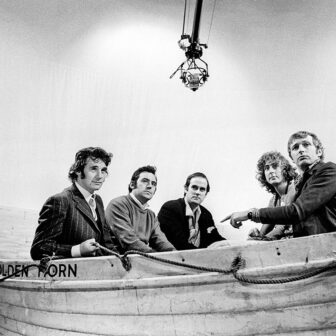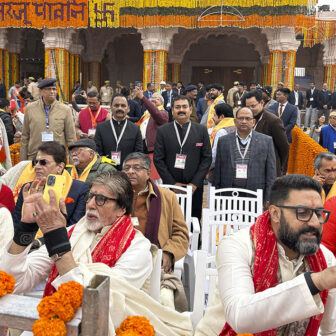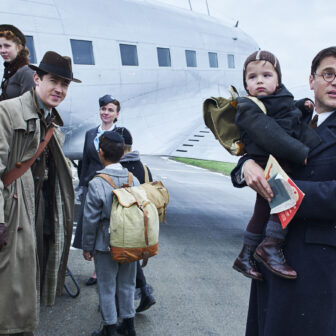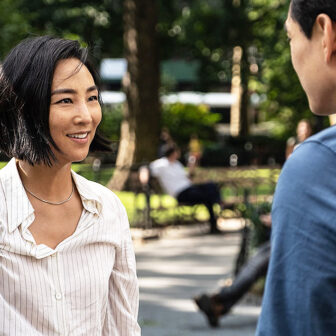In Charlie’s Country, there’s a key moment that’s both gross and grotesque. David Gulpilil’s Charlie, confronting the admonitions of a police officer, ejects a set of false teeth and says, “I can’t eat with them, I can’t eat without them, I’m starving.” And indeed he looks it; lithe and active, but a fair bag of bones. Sometime, there’ll be a dentist visiting the community. With his mate Black Pete (Peter Djigirr, remembered from Ten Canoes) Charlie goes off shooting buffalo; they’re in search of real sustenance, relief from the junk food in the local store. The rifle, the carcass, and even the carefully crafted wooden spear are confiscated. Charlie’s funds in the ATM, casually disbursed around the place, run out. Relations with local police seem, at the outset, to be made of amiable ritual banter; but things will turn ugly.
Along the way, we visit two aspects of Darwin, the well-tended tropical streets of the CBD – the Darwin most white visitors know – and the littered camping spaces where the long-grassers, Aboriginal itinerants, hang out drinking. Darwin isn’t Charlie’s home country, which is a long way off in Arnhem Land, with a red dirt road and a police station among overcrowded houses. The film undermines popular sentimentalities about Aboriginal communal life and sharing; Charlie, a bit fed up with the claims of kinfolk, wants a house to himself. Off on his own with a new clutch of spears, in a beautiful, green-glowing jungle, he is seen in his own bush shelter. Spearing and cooking a large barramundi, he sings to the fish as he eats; but then torrential rain sets in, and we know that, as a Darwin doctor tells him, Charlie’s lungs are packing up. After my first viewing, dining in Canberra, we had to go for the barramundi.
After the second, in Sydney, my viewing companion remarked that of course, there had to be a happy ending. Indeed; the audience has been put through a fair ordeal by then, and that ending is double-edged. It affirms Aboriginal survival – under great difficulties, and on Aboriginal terms. At the same time, Charlie’s Country has to make its way as an entertainment product, and therefore make suburban white audiences feel better about the histories of loss, dispossession and sheer degradation which hang behind the story. We can visit that country only as tourists, but it becomes part of everyone’s imagined Australia – imagined, even desired; there are more white visitors each year to the Top End’s Garma festival (and it takes over mainstream TV on next Monday’s Q&A; unthinkable developments once).
However the audiences take this film – and I’ve felt some of them pushing it away, with comments on how they liked Samson and Delilah better, as though any comparison was invited – it pulls a powerful undertow. Several histories are at work; for one, Rolf de Heer’s eclectic range as a director, and this is arguably his best film. Gulpilil’s long track record as a performer goes back to his work on Nicolas Roeg’s Walkabout at age sixteen, and he had his magnetism then. Here, at sixty, he is a co-author with de Heer, and not only as co-writer; this is one case where performance is much more than instrumental. It is at the source and centre of the work; the weathered, expressive face, with steady humour in the eyes; the tangle of grey hair, the movements of the long dancer’s body are visually and dramatically central throughout. Thus, when Charlie is made abject in the gruelling jail sequences, the actor takes this character’s extremity to a level where it is inescapably representative. It is about race, it is about class and caste – there’s a lethal accuracy in the scripting and presentation of the young woman parole officer (Bojana Novakovic), groomed and trained as she is to be an agent of the system, fully confident that she’s doing some good in a difficult frontier world. It is about institutionalised denial; it is about the revenge of the coloniser on the colonised who refuse to lose identity and disappear. Charlie’s country is hers, and ours.
Irresistibly perhaps, some have been reading Gulpilil’s own life story into the tale, making it reinforce an old mythography of the gifted and doomed Aboriginal artist, rewriting Namatjira and Robert Tudawali, trading in over-determined tragedies. The biographical element, however, could be taken differently. Charlie hangs on to a crumpled piece of paper; we don’t see what’s on it until late in the story. Finally, from his point of view, we look at a battered photograph of the Sydney Opera House, fronted by milling crowds, on the day the building was opened by the Queen. Forty years later he, Charlie/David, hangs on to the memory: he was one of the dancers there, on that emblematic day.
Rising to a kind of recovery, he will use the memory in a resonant story for children. From there, we must wish the survivor David Gulpilil what he is said to want for himself: more work, more work in films. They gave him the best actor’s award in the special category, Un Certain Regard, at Cannes, and they were right; he’s one of the best film actors on the planet.
The second half of 2014 has film festivals wall-to-wall. In Canberra, a documentary festival, Stronger than Fiction, is running this weekend, with the premiere of the much-anticipated Message from Mungo. This film, from the producer and director Andrew Pike with the historian Ann McGrath, is a closely woven meditation on Lake Mungo’s past and present, involving traditional custodians, archaeologists, historians and pastoralists. It has been long in preparation, and undoubtedly worth waiting for. Canberra’s main international festival will run from 23 October to 9 November. Melbourne’s major event runs from now to 17 August; there is little need here to urge commitment and bookings, since many offerings are quickly selling out. As with Sydney’s program, documentaries are packing them in; and bookings are heavy for works from the established masters – Resnais’s Life of Riley, Godard’s new Goodbye to Language and his Masculin-Féminin (1966), and Truffaut’s The 400 Blows (1959). The annual Israeli film festival will run through later August in six capital cities, plus Byron Bay; by a wry coincidence (or is it?), the Arab film festival will run in the same period in Sydney, Melbourne and Canberra. Those with the stamina – and the cash – to take in both will, without question, come out the wiser. The Palestinian film festival is to follow in November. •





